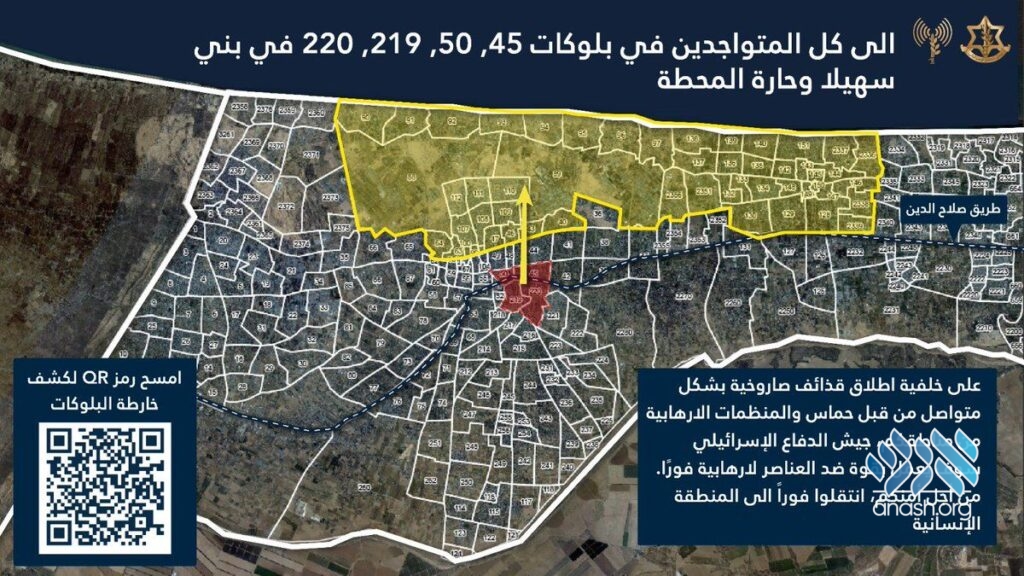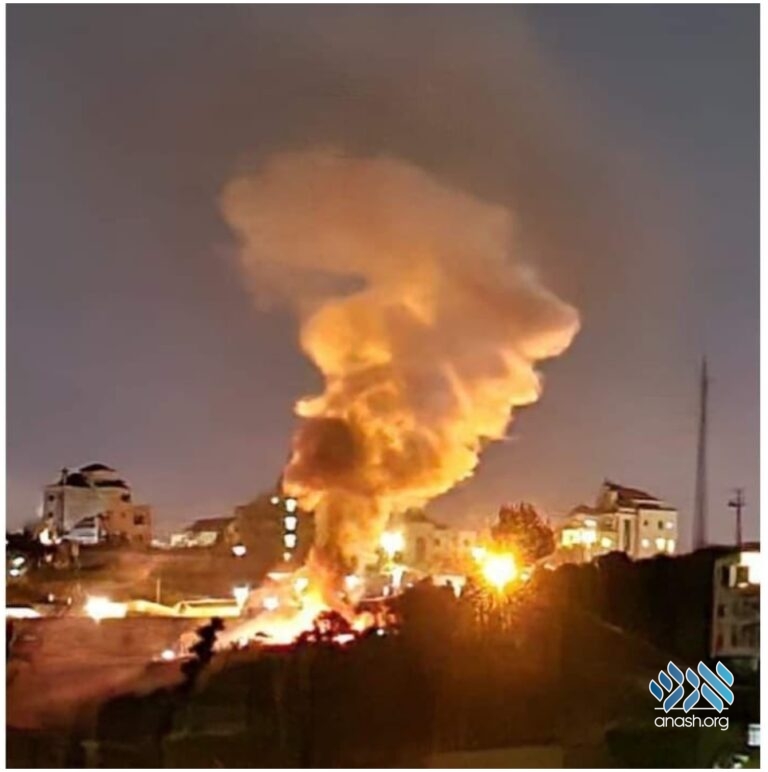י׳ אב ה׳תשפ״ד | August 13, 2024
War Day 312: Car Explodes Near Chevron, U.S. Approves Fighter Jets Sales
War Summary, Day 312: A car exploded in the Arab section of Chevron causing several Palestinian casualties and possible deaths, US Secretary of State approved the sale of 25 F-15IA fighter jets and kits for Israel’s F-15 aircrafts in an $18.82 billion sale, and pressure from multiple countries is on Hamas to join the summit on Thursday to discuss the war.

War Summary, Day 312: A car exploded in the Arab section of Chevron causing several Palestinian casualties and possible deaths, US Secretary of State approved the sale of 25 F-15IA fighter jets and kits for Israel’s F-15 aircrafts in an $18.82 billion sale, and pressure from multiple countries is on Hamas to join the summit on Thursday to discuss the war.
By Mrs. Bruria Efune
War Summary, Day 312:
115 held captive in Gaza.
41 hostages confirmed murdered in Gaza.
116 living hostages rescued.
24 hostage bodies rescued.
1,619 Israelis killed.
332 fallen soldiers and police in the battle in Gaza.
19 fallen soldiers in Northern Israel.
9 fallen soldiers in Judea & Samaria.
20,620 estimated rockets fired at Israel.
90,000 Israelis displaced from their homes.
1 Jewish nation united in prayer, charity, and good deeds.
Top Headlines:
- Intense efforts to bring Hamas to negotiation summit
- Iran might hold off attack for negotiations summit
- Blinken delayed his trip to the Middle East due to the uncertain security situation
- Hamas attempted a launch at Tel Aviv
- IDF is implementing immediate evacuations of neighborhoods where launches are made from
- A car exploded near Chevron, in a possible failed terror attack
Hostage Updates:
U.S. President Biden says that achieving a ceasefire deal is getting harder, but he’s not giving up. Responding to questions, he confirmed that he is now expecting Iran to hold off on their attack on Israel, if a ceasefire is achieved. This comes as The American State Department says that Qatar is working to get Hamas to participate in the August 15th negotiations summit, which will be held in Doha, Qatar. The Lebanese Al-Akhbar newspaper says that Egypt is also working to convince Hamas to join the summit, so that it won’t look like Hamas are to blame for the lack of ceasefire. They also report that Egypt is proposing an interim ceasefire agreement, to precede a hostage release agreement.
According to the Wall Street Journal, Hamas is now demanding that Israel stop military operations in Gaza “to prove that Israel is serious about the agreement.”
Hamas now wields all the power, and has three choices on the table:
- Decide not to go to the summit, and have Hezbollah and Iran attack Israel, possibly launching a Lebanon war.
- Go to the summit but turn down all offers, blame the lack of agreement on Israel, and then have the Hezbollah and Iran attack on Israel as a result—with possibly less international support for Israel.
- Go to the summit and agree to a an offer that in the first phase releases 20-30 Israeli hostages, and in turn gets 6 weeks of ceasefire, IDF withdrawal from all populated areas (and maybe even all areas), the release of hundreds of terrorists from Israeli prison, and negotiations for a second phase leading to a lasting ceasefire—or the Hezbollah and Iran attack after the 6 weeks of ceasefire, when negotiations for the second phase fail.
In all options, Hamas gets their goals advanced, and Israel likely gets blamed for the lack of ceasefire. Mediators will also apply extra pressure on Israel to lower conditions for an agreement, including allowing arch-terrorists out of prison, giving up the Philadelphi Corridor, and allowing Hamas to drag out negotiations leading to days of ceasefire in exchange for nothing—all in the name of preventing a wider regional war with Lebanon and Iran. America will cite its huge investment in bringing huge military support for Israel as added pressure for negotiations.
Iran & Proxies Attack Updates:
Defense Minister Yoav Gallant visited an intelligence base in Northern Israel, and in a statement, said, “I am aware of the tensions and the great burden placed on the citizens of Israel. We are following what is happening, in Beirut, in Tehran, and in other places. We are engaged both in removing the threats and preparing all possibilities, in order to be able to attack wherever we decide.”
In addition to bolstering defenses along the Lebanon border, the IDF also deployed significant numbers of troops along the Syrian border in the Golan Heights, in case Iran sends its proxies to invade from Syria. There are currently tens of thousands of Iranian-backed militia in Syria stationed far from the Syria-Golan border, but Israel is monitoring them closely.
Pentagon spokesman, Pat Ryder said, “The US is working intensively to calm tensions in the region, we have transferred the additional capabilities, including battleships and submarines, to the region to allow us to protect our forces but also to assist in the defense of Israel.” 40,000 American soldiers are now under the command of CENTCOM in the Middle East, which is about 8,000 more than during normal times. (According to Israel Hayom)
Reports on when and how Iran will attack Israel are so varied, it’s almost funny. It ranges from imminent, to after the negotiations summit on Thursday (which can last weeks). Severity ranges from Iran being deterred and trying to avoid a heavy IDF response, to preparing for a heavy 3-day attack that could escalate to war. These reports all come from trusted media outlets citing “anonymous U.S. and Israeli intelligence officials.”
What we do know as fact:
- Iran is unlikely to attack tonight, as it’s already 2:00 a.m. in Israel.
- U.S. Secretary of State Blinken delayed is visit to Israel today, due to the uncertainty of the situation.
- The proposed hostage negotiations summit is on Thursday, President Biden thinks that if Hamas agrees to go, Iran will likely hold off their attack.
- Iran claims to be carrying out military exercises in the north of the country.
In addition, there are strong indications (but not certain) that Hezbollah is ready to attack, and Iran is almost ready.
Gaza Front Updates:
Hamas launched two long-range rockets towards Tel Aviv. One landed short and fell in Gaza, and the other landed in the Mediterranean Sea, off the coast of Tel Aviv. No sirens were triggered.
Hamas was very proud of their launch, and published a video of it. The launch was from a humanitarian tent in Khan Younis, and on a makeshift rocket launcher. That Hamas are proud of such a failure, is indicative of their extremely low fire capabilities at this point. The IDF assesses that Hamas still have long-range firing capabilities, but is crippled by a severe lack of mismatching supplies. Hamas last fired at Tel Aviv in late May.
Thank G-d, the IDF did not announce any fallen heroes today.
Four divisions of IDF troops are currently operating in Gaza: the 252nd Division along the Netzarim Corridor, and on pinpoint operations in Central and Northern Gaza; the Gaza Division in the buffer zone; the 98th Division in Khan Younis; and the 162nd Division in Rafah and along the Philadelphi Corridor.
Hamas’s terrorist military is divided into battalions and brigades by city and neighborhood. Every brigade hides their weapons, rockets, and launchers, spread throughout their neighborhood. Terrorists memorize the locations of weapons in their own neighborhood, so that they can run around unarmed, and pick up a weapon whenever they need it. The units which launch rockets know where each one is hidden, and when ready, can locate and carry it to the nearby launcher. These hiding places are typically in homes, schools, tunnels, or buried in difficult to find places. The IDF now has the mammoth job of finding and destroying all these weapons, without accidentally harming hostages. This can either be done with intense searches, or by arresting and interrogating terrorists from every neighborhood in Gaza. Eliminating the terrorists also helps, but leaves the weapons to be found by civilians, who may support or join Hamas.
Troops station along the Netzarim Corridor (which divides the north of Gaza from the south) continue to carry out short raids in Central and Northern Gaza, in which they locate and direct airstrikes at Hamas sites, including over the past couple days, sniper positions, rocket launchers, hidden weapons, and observation posts.
The IDF issued new evacuation warnings for the area in Khan Younis from where rockets were launched towards Tel Aviv today. The area was previously left out of the evacuation warning for most of Khan Younis, due to the presence of a significant number of displaced civilians and humanitarian tents. The IDF is now implementing a quick policy of evacuating any neighborhood from where rockets were launched, and declaring it an active combat zone. After today’s rocket launch Gazan social media quickly buzzed with people trying to figure out where it was launched from, and who were the unlucky souls who would now have to evacuate—indicating that civilians are catching on. The question is if this will deter Hamas, or only stir anger at them.
The IDF says that after Hamas launched a rocket from (an evacuated area of) Khan Younis towards Ein Hashlosha yesterday, the terrorists who launched it were almost immediately eliminated in a drone strike. Over the past day in Khan Younis, troops eliminated several other terrorists, and destroyed multiple Hamas sites.
In Rafah, troops located valuable intelligence materials, as well as Hamas weapons and tunnel shafts, all while eliminating terrorists in the way.
In an NPR interview published today, Based Niam, a Hamas leader in Qatar, says that Hamas has no regrets about the October 7th attack, and if not given their “rights,” will attack again and again.
Gaza Humanitarian Efforts Updates:
The IDF had to temporarily close one of the routes in Rafah which are used to deliver humanitarian aid, after Hamas fired at IDF troops protecting the route, making it an “active combat zone.”
Yesterday, 144 trucks carrying humanitarian goods were transferred to Gaza via the Kerem Shalom (113 trucks) and Erez (31 trucks) crossings.
About 600 trucks are waiting for collection on the Gazan side of Kerem Shalom.
31 aid trucks were coordinated to northern Gaza yesterday.
6 tankers of cooking gas designated for the operation of vital humanitarian infrastructure entered Gaza yesterday, at the request of humanitarian aid organizations.
3 bakeries are operational (7 in northern Gaza and 6 in central Gaza), producing close to 3 million pita loaves a day.
Northern Front Updates:
Hezbollah in Lebanon continued with a few heavy barrages of rocket fire and drone attacks on Israel’s north, reaching as far as 10 kilometers from the Lebanon border. Damage was caused, but no injures were reported. Most launches to civilian areas were intercepted by Israeli air defenses.
The IDF carried out a large number of airstrikes in Southern Lebanon, including observation posts, launch sites, and a command room, and also several direct hits on Hezbollah terrorists. While reports on ground indicate multiple eliminations, Hezbollah only reported one, and maintains a death toll of 407. It’s largely believed that Hezbollah under-reports their own deaths.
The Lebanese Al-Akhbar newspaper reported that the American envoy Amos Hochstein is scheduled to visit Lebanon tomorrow, to meet with Prime Minister, Speaker of the Parliament, and Foreign Minister (who each come from different political parties and religious sectors). Sources told the paper that Hochstein is coming with a “new initiative for pacification, and has ideas to prevent a major explosion,” but no one else knows the content of the initiative yet.
Judea and Samaria Updates:
Palestinian terrorists have been carrying out firebombing attacks on civilians in Pisgat Ze’ev, a northeastern neighborhood of Jerusalem, by throwing Molotov cocktails over the security barrier. Today, Israeli Border Police lay in ambush to catch them. A group of Palestinians began hurling Molotovs over the fence, when one climbed onto the wall and threw a firebomb. A police sniper shot him, and the 16-year-old terrorist later died in the hospital.
In a later incident on Tuesday night, a car exploded in the Arab section of Chevron (Hebron), causing several Palestinian casualties, and possibly dead. The IDF is investigating, and carrying out a search for the remains of the vehicle (which were suspiciously quickly removed), to understand if this was a car rigged with bombs for a terror attack, which failed and exploded too early (thank G-d).
Last night, the IDF demolished the home of Aysar Barghouti and Khaled al-Kharouf, two terrorists who killed two people in a terror attack on January 7th. In the attack, the terrorists shot two Palestinians who they mis-identified as Israelis.
General Updates:
The US Secretary of State approved the sale of 25 F-15IA fighter jets (specifically an Israeli modified variant), and kits for Israel’s F-15 aircrafts, in an %18.82 billion sale, of which deliveries are expected to begin in 2029.
Defense Minister Gallant thanked the U.S. Secretaries of Defense and State for assisting in Israel’s maintaining a qualitative military edge, and added, “As we fight to defend Israel on 7 different fronts, your message of support and commitment to Israel’s security, are clear.”
Israel is simultaneously boosting local arms production in order to be less dependent on international purchases in munitions and armored vehicles. This is a process that could take 2-3 years.




We appreciate your feedback. If you have any additional information to contribute to this article, it will be added below.